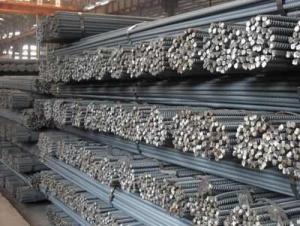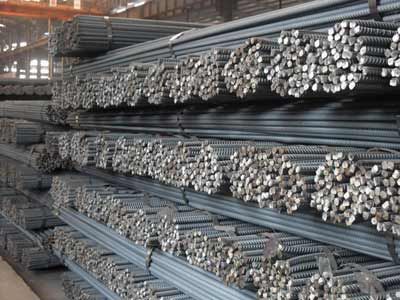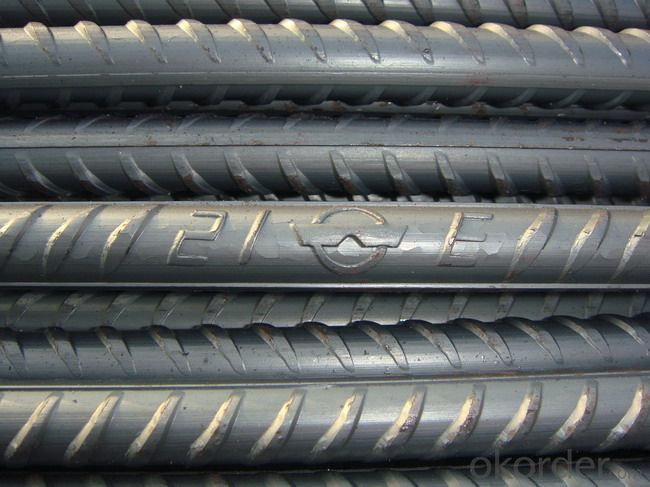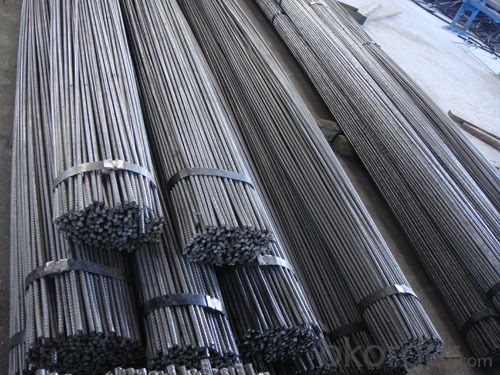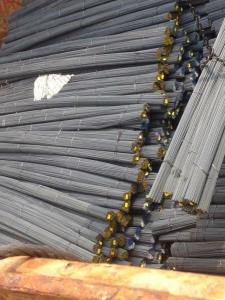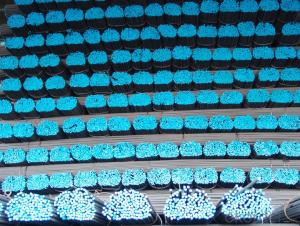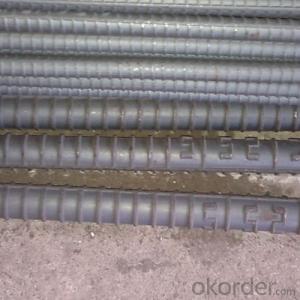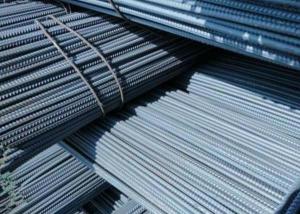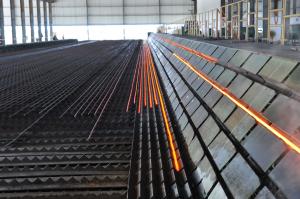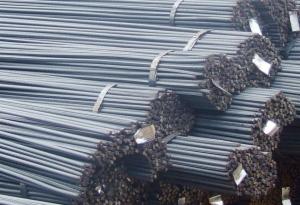8mm*50.27mm deformed steel bar deformed steel bar
- Loading Port:
- Tianjin
- Payment Terms:
- TT or LC
- Min Order Qty:
- 25 m.t.
- Supply Capability:
- 100000 m.t./month
OKorder Service Pledge
OKorder Financial Service
You Might Also Like
Product Description:
OKorder is offering 8mm*50.27mm deformed steel bar deformed steel bar at great prices with worldwide shipping. Our supplier is a world-class manufacturer of steel, with our products utilized the world over. OKorder annually supplies products to European, North American and Asian markets. We provide quotations within 24 hours of receiving an inquiry and guarantee competitive prices.
Product Applications:
8mm*50.27mm deformed steel bar are ideal for structural applications and are widely used in the construction of buildings and bridges, and the manufacturing, petrochemical, and transportation industries.
Product Advantages:
OKorder's deformed steel bar are durable, strong, and resist corrosion.
Main Product Features:
· Premium quality
· Prompt delivery & seaworthy packing (30 days after receiving deposit)
· Corrosion resistance
· Can be recycled and reused
· Mill test certification
· Professional Service
· Competitive pricing
Product Specifications:
| Minimum Order Quantity: | 25MT | Unit: | m.t. | Loading Port: | China Main Port |
| Supply Ability: | 800000 MT/YEAR | Payment Terms: | TT or LC |
Product Description:
Specifications of Deformed Steel Bar:
Standard | GB | HRB335, HRB400, HRB500 | |
UK | G460B, B500A, B500B,B500C | ||
USA | GR40, GR60 | ||
Diameter | 6mm,8mm,10mm,12mm,14mm,16mm,18mm,20mm, 22mm,25mm,28mm,32mm,36mm,40mm,50mm | ||
Length | 6M, 9M,12M or as required | ||
Place of origin | Hebei, China mainland | ||
Application | building,construction,road,bridge etc | ||
Brand name | DRAGON | ||
Theoretical weight and section area of each diameter as below for your information:
Diameter(mm) | Section area (mm²) | Mass(kg/m) |
6 | 28.27 | 0.222 |
8 | 50.27 | 0.395 |
10 | 78.54 | 0.617 |
12 | 113.1 | 0.888 |
14 | 153.9 | 1.21 |
16 | 201.1 | 1.58 |
18 | 254.5 | 2.00 |
20 | 314.2 | 2.47 |
22 | 380.1 | 2.98 |
25 | 490.9 | 3.85 |
28 | 615.8 | 4.83 |
32 | 804.2 | 6.31 |
36 | 1018 | 7.99 |
40 | 1257 | 9.87 |
50 | 1964 | 15.42 |
Usage and Applications of Deformed Steel Bar:
Deformed bar is widely used in buildings, bridges, roads and other engineering construction. Big to highways, railways, bridges, culverts, tunnels, public facilities such as flood control, dam, small to housing construction, beam, column, wall and the foundation of the plate, deformed bar is an integral structure material. With the development of world economy and the vigorous development of infrastructure construction, real estate, the demand for deformed bar will be larger and larger..
Packaging & Delivery of Deformed Steel Bar:
Packaging Detail: products are packed in bundle and then shipped by container or bulk vessel, deformed bar is usually naked strapping delivery, when storing, please pay attention to moisture proof. The performance of rust will produce adverse effect.
Each bundle weight: 2-3MT, or as required
Payment term: TT or L/C
Delivery Detail: within 45 days after received advanced payment or LC.
Label: to be specified by customer, generally, each bundle has 1-2 labels
Trade terms: FOB, CFR,
Note:
1. Our products are produced according to national standard (GB), if not, supply according to national standards (GB) or agreement as customer required.
2. Other Grade and Standard Deformed Steel Bar we can supply:
Grade: GR40/GR60, G460B/B500A/B500B/B500C,BST500S
Standard: ASTM, BS, DIN
The Minimum Order Quantity of these products is high, and need to be confirmed.
3. We can not only supply Deformed Steel Bar; if you need anything about building materials, please contact us for further information.
4. Please send us your detail specifications when inquire. We will reply to you as soon as possible. We sincerely hope we can establish a long stable business relationship.


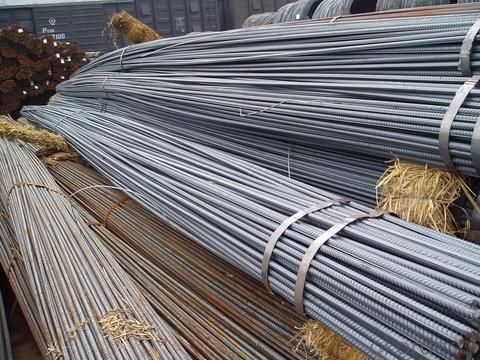
FAQ:
Q1: Why buy Materials & Equipment from OKorder.com?
A1: All products offered byOKorder.com are carefully selected from China's most reliable manufacturing enterprises. Through its ISO certifications, OKorder.com adheres to the highest standards and a commitment to supply chain safety and customer satisfaction.
Q2: Can stainless steel rust?
A2: Stainless does not "rust" as you think of regular steel rusting with a red oxide on the surface that flakes off. If you see red rust it is probably due to some iron particles that have contaminated the surface of the stainless steel and it is these iron particles that are rusting. Look at the source of the rusting and see if you can remove it from the surface.
- Q: How are steel rebars classified based on their surface patterns?
- Steel rebars are classified based on their surface patterns into three main categories: plain, deformed, and ribbed. Plain rebars have a smooth surface and are primarily used in applications where the concrete needs to slide along the steel surface. Deformed rebars have raised patterns or deformations on their surface, enhancing the bond strength between the steel and the concrete. Ribbed rebars have continuous longitudinal ribs that provide additional surface area for the concrete to adhere to, resulting in better load transfer capabilities.
- Q: How do steel rebars contribute to the structural stability of a building?
- Steel rebars contribute to the structural stability of a building by providing reinforcement to concrete structures. They increase the tensile strength of concrete, allowing it to withstand bending and stretching forces. This reinforcement helps prevent cracks and failures in the building, making it more resistant to seismic activity, heavy loads, and other external factors that could compromise its stability.
- Q: What are the safety considerations when handling steel rebars?
- Some safety considerations when handling steel rebars include wearing appropriate personal protective equipment (PPE) such as gloves, safety glasses, and steel-toed boots to prevent injuries from sharp edges and falling objects. It is important to ensure proper lifting techniques and use mechanical aids when moving heavy rebars to avoid strain or back injuries. Additionally, workers should be cautious of tripping hazards caused by loose or protruding rebars and follow proper storage procedures to prevent accidental falls. Regular inspection and maintenance of the rebars are crucial to identify any potential defects or weaknesses that could compromise their structural integrity and cause accidents.
- Q: What is the maximum diameter of steel rebars used in residential construction?
- The maximum diameter of steel rebars typically used in residential construction ranges from 12 to 20 millimeters.
- Q: Are steel rebars suitable for use in hospital construction?
- Yes, steel rebars are suitable for use in hospital construction. Steel rebars, also known as reinforcing bars, are commonly used in construction projects to provide strength and stability to concrete structures. In hospital construction, where safety and durability are of utmost importance, steel rebars offer several advantages. Firstly, steel rebars have high tensile strength, meaning they can withstand heavy loads and resist deformation. This is crucial in hospital construction, where the building needs to support the weight of medical equipment, patients, and other infrastructure. Additionally, steel rebars enhance the overall structural integrity of the hospital, ensuring long-term stability and safety. Moreover, steel rebars have excellent fire resistance properties. Hospitals are considered high-risk buildings, with potential fire hazards due to the presence of flammable materials and electrical equipment. Steel rebars can withstand high temperatures without losing their strength, providing enhanced fire protection to the structure. Furthermore, steel rebars are corrosion-resistant, protecting the concrete from damage caused by moisture and chemicals. Hospitals often have high humidity levels and are exposed to various chemicals used in medical procedures. By using steel rebars, the risk of corrosion and subsequent structural deterioration is minimized, ensuring a longer lifespan for the hospital building. Lastly, steel rebars are readily available and cost-effective. Hospital construction projects often have strict timelines, and using steel rebars allows for efficient construction and quick installation. Additionally, the availability of steel rebars in the market ensures a competitive price, making it a cost-effective choice for hospital construction. In conclusion, steel rebars are indeed suitable for use in hospital construction. Their high tensile strength, fire resistance, corrosion resistance, and cost-effectiveness make them an ideal choice for ensuring the safety, durability, and long-term stability of hospital buildings.
- Q: Can steel rebars be used in structures with high resistance to earthquakes?
- Yes, steel rebars can be used in structures with high resistance to earthquakes. Steel rebars are commonly used in seismic-resistant structures due to their high tensile strength and ductility. They are able to absorb and dissipate the energy generated during an earthquake, providing reinforcement and stability to the structure. Additionally, modern construction techniques and design codes ensure that steel rebars are properly integrated into earthquake-resistant structures to enhance their overall resilience.
- Q: Can steel rebars be used in the construction of hospitals?
- Yes, steel rebars can be used in the construction of hospitals. Steel rebars are commonly used in reinforced concrete structures to provide strength and stability. In hospital construction, where safety and durability are crucial, steel rebars are essential for reinforcing concrete foundations, columns, beams, and other structural elements. They help ensure the structural integrity of the hospital building, making it resilient and capable of withstanding various loads and potential hazards.
- Q: What are the different grades of steel rebars available?
- The different grades of steel rebars available include Grade 40, Grade 60, Grade 75, and Grade 80, which indicate the minimum yield strength of the rebars in thousands of pounds per square inch (ksi).
- Q: How do steel rebars impact the overall flexibility of a structure?
- Steel rebars, also referred to as reinforcing bars, play a crucial role in enhancing the overall flexibility of a structure. These bars are typically utilized in reinforced concrete structures to bolster tensile strength and enhance the structural integrity of the building. The integration of steel rebars in concrete significantly augments the flexibility of a structure. Concrete itself possesses strength in compression but weakness in tension. By incorporating rebars, the structure becomes more adept at withstanding tensile forces and resisting bending or deformation caused by external loads or environmental factors. The rebars function as reinforcement by assimilating and dispersing tensile forces throughout the structure, aiding in the prevention of cracks and ensuring a more uniform distribution of stress. This is particularly vital in regions prone to seismic activity or high wind loads, where structures must possess the ability to flex and absorb the energy exerted upon them. Furthermore, the presence of steel rebars also permits the creation of thinner and lighter concrete sections. This contributes to the overall flexibility of the structure by reducing the dead load, rendering it more responsive and adaptable to diverse conditions. In summary, steel rebars have a significant impact on the overall flexibility of a structure by furnishing tensile strength, averting cracks, distributing stress, and enabling the implementation of lighter and thinner concrete sections. By enhancing the structural integrity and resilience, the inclusion of rebars ensures that the building can withstand external forces while preserving its stability and flexibility, ultimately contributing to its longevity and safety.
- Q: What is the effect of steel rebars on the electrical conductivity of concrete?
- Concrete's electrical conductivity is significantly influenced by steel rebars. The inclusion of steel rebars in concrete enhances its overall electrical conductivity as steel is an excellent conductor. This is because steel rebars create a network of conductive paths within the concrete, facilitating the smooth flow of electrical current. Considering the electrical conductivity of concrete is crucial, particularly in situations that necessitate electrical grounding or conductivity. Steel rebars play a vital role in establishing a low-resistance pathway for electrical current, enhancing the overall electrical conductivity of the concrete structure. Nevertheless, it is important to acknowledge that the presence of steel rebars can pose challenges in certain scenarios. For instance, in electrical installations requiring insulation or areas where electrical isolation is essential, the conductivity provided by steel rebars may not be desired. In such cases, additional measures such as insulation or isolation techniques must be employed to prevent undesired electrical currents from traversing through the concrete. In conclusion, the impact of steel rebars on the electrical conductivity of concrete is contingent upon the specific requirements and applications of the concrete structure. A thorough understanding of the intended use and the implementation of appropriate measures will ensure that the electrical conductivity of the concrete meets the desired specifications.
Send your message to us
8mm*50.27mm deformed steel bar deformed steel bar
- Loading Port:
- Tianjin
- Payment Terms:
- TT or LC
- Min Order Qty:
- 25 m.t.
- Supply Capability:
- 100000 m.t./month
OKorder Service Pledge
OKorder Financial Service
Similar products
Hot products
Hot Searches
Related keywords
